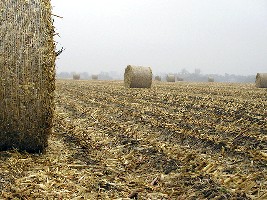A team of university, government, and national laboratory researchers ran simulations to gauge the impact of biofuel feedstocks on agricultural land. The findings are published in the January/February 2011 issue of Agronomy Journal (free full-text access for 30 days following publication).
The study, funded by the USDA’s Agriculture Research Service, simulated experiments lasting from 79 to 134 years to predict the potential of no-tillage management to maintain soil organic carbon. The five experiments used a process-based carbon balance model.
Management practices in these experiments ranged from single cropping to two or three year crop rotations; manure, no fertilizer or fertilizer additions; crop residue returned, and crop residue removed. The predictions also factored in diverse climates, soil conditions, fertility management, cropping systems, and crop residue removal practices.
The simulation results indicated that the quantities of crop residue that can be sustainably harvested without jeopardizing stocks of soil organic carbon were influenced by initial soil organic carbon stocks, crop rotation intensity, tillage practices, crop yield, and climate.
The simulation results suggest that planning for biofuels made from agricultural residues will need to balance the use of those residues as feedstocks against their value in regenerating the stock of carbon in the soil. This stock of organic carbon preserves soil functions and ensures the sustainable long-term production of biofuel feedstock.
Read more: Engineering Prof. Computes Available Biofuel Crop Lands
* * *


 RSS - Posts
RSS - Posts
[…] Read more: Long-Term Impacts of Biofuels on Land Analyzed […]
[…] Read more: Long-Term Impacts of Biofuels on Land Analyzed […]